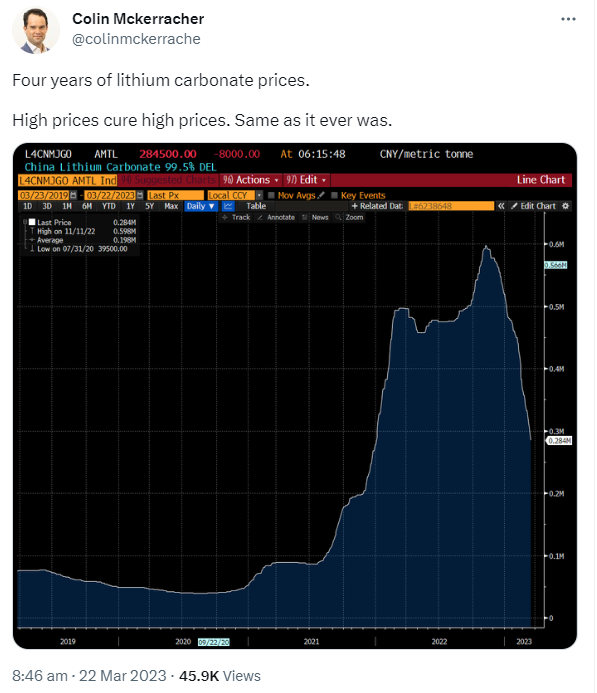
What was the biggest EV industry news in Q1 2023?
Posted by Jade: Apr 05, 2023 • 5 min read
Our Head of Policy & Public Affairs, James McKemey reflects on the biggest EV industry news in Q1.
Wow. We’re a quarter of the way through 2023 already. But with the pace of battery electric vehicle (BEV) news - new car releases, new charging rollout milestones, new media controversies - seemingly growing, it can be hard to see the wood for the trees.
In this blog, we’ll try to pick a stand out news item that has really mattered so far this year.
1. Lithium commodity prices have started to normalise
Background - price makes the difference
Even without the 2030/35 ban, BEVs are going to win. After all, they’re already the best form of car - they’re faster, safer, more convenient (once you’ve got your charging sorted) and easier to drive.
While technological advancements will continue to widen their gap in quality with internal combustion engine cars (ICE), the most important thing is to make them more accessible. To that end, reducing their cost is critical, and the best way to do this is to reduce the cost of making the battery.
Since 2010, the cost to make a kWh of battery pack has fallen around 85%. So it’s fair to say progress has been going rather well. But in recent years it has slowed or paused, and in 2022 it actually slightly reversed with packs getting slightly more expensive to manufacture.
Economies of scale vs supply outstripping demand
The reason costs have fallen markedly since 2010 is largely due to the manufacture of lithium-ion cells scaling. More and larger factories, more production, more developed supply chains have reduced unit cost.
However, on the other side of the equation, the demand from rapidly scaling production has caused the mineral supply to become pinched, particularly from early 2021, which has led to a dramatic spike in price for certain key components, perhaps most notably (and symbolically) lithium.
These two forces have effectively cancelled each other out, with cell manufacture prices at $150 per kWh in 2020 and $151 per kWh 2022, according to Bloomberg New Energy Finance (BNEF). But that’s not because of the market stasis; the raw material costs have grown significantly as a proportion of the total cost to manufacture battery packs.
A cause for cautious optimism in the commodity markets
It’s always a little risky to determine movements in market pricing as concrete changes in market dynamics, but the downward trend in the price of lithium so far this year is both so pronounced and so important that we’ve chosen to make it our BIG NEWS OF Q1.

Source: Twitter
Again, we must stress that prices are subject to change and that lithium is only a minority component of lithium-ion batteries (see graphite and nickel in particular for NMC cells), but since this fall is in response to significant investment in developing lithium production, it gives us hope that more moderate prices can endure.
Combining falling raw material costs with the significant reduction in manufacturing costs that have taken place in recent years (and will continue for years to come) supports BNEF’s argument that we expect to see price parity to manufacture an equivalent ICE and BEV vehicle.
So BEVs are better, and as of Q1 2023 it looks like they’ve returned to the path that will soon make them cheaper to buy.
2. Other contenders for the biggest news of 2023 Q1
Gas prices continue to fall
It looks like the action that Putin’s war in Ukraine spurred European governments into, coupled with a relatively warm winter, have normalised natural gas wholesale prices, thus holding out the promise of more sane electricity prices to come - albeit not immediately due to the price cap mechanism.
Of course, in the long run we must wean ourselves from our reliance on natural gas. This won’t be easy, but it does bode well for sustained cheaper electricity pricing.
Sodium-ion batteries make strides
Not as energy dense as lithium-ion technologies, but improved to a point where they may soon be good enough, sodium-ion cells hold out promise of much cheaper and accessible raw materials. It’s just possible that in years to come they’ll have a big part to play in affordable BEVs.
New BEVs
There’s new BEV announcements seemingly weekly these days! Perhaps the best received in Q1 have been new products from Kia in the form of the EV9 and EV5, but your author is not a big fan of SUVs, so I’m afraid they didn’t make the cut.
Dodgy news from the EU on the e-fuels
In a disappointing twist, the EU has agreed to allow ICE vehicles to be classed as zero emission so long as they run e-fuels. For the uninitiated, e-fuels are synthetic fuels, typically derivative from hydrogen (and huge quantities of energy), that are capable of being combusted in ICE and/or (significantly) jet engines. Since e-fuels are designed to replicate fossil fuels, it isn’t immediately clear how to prevent these vehicles from filling with still abundant fossil fuels.
This is a particular concern when you factor in how much energy is required to produce sustainable e-fuels and the demand that long haul aviation is likely to put on would-be suppliers.
It suggests that anyone buying such a car is likely to be paying a pretty, pretty penny to operate it - or flaunt the rules and run on petrol, illegally. Or they’ll choose a vastly superior BEV and save a fortune instead.
It does seem a curiously short sighted decision. And mercifully one the UK government has specifically ruled out.
To stay up to date with the latest news, follow us on Facebook, Twitter, LinkedIn and Instagram for all the latest updates on new chargepoints and more.
